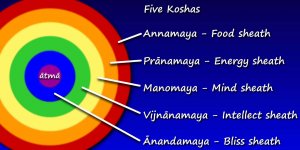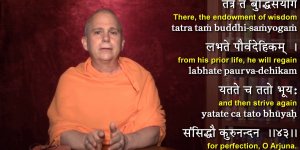| TV Channels / Documentaries |
The Inner Journey: A Course in Meditation
Part 2: Origins and Types of Meditation
A video presentation by Swami Tadatmananda Saraswati, Arsha Bodha Center, United States
(Tapescript)
The lessons in this course draw heavily on my personal experience, both as a practitioner and as a teacher of meditation.
But the fact is, I really can't take credit for the teachings presented here. I've been fortunate to receive a body of spiritual wisdom that's been passed down from generation to generation for millennia.
These teachings come from the rishis, the sages of ancient India.
More than three thousand years ago, the rishis sought to understand life s deepest mysteries and fundamental realities that lie beyond the scope of human experience.
Their exploration ultimately led them to turn their attention away from the world and look deeply within themselves.
The rishis must have seemed quite strange to others whose lives were focused on their families, farms, and livestock. To common folk at that time, closing your eyes to the world and looking within was a radical and unprecedented act.
This fundamental shift of attention is the prototype for all meditation practices that were to emerge in the East.
This shift is vividly described in a well-known scripture, the Katha Upanishad: The Creator made our eyes look outwards, so we see the world outside, not the true, inner Self.
But a wise sage discovered the inner Self by turning his attention within, seeking enlightenment.
In this verse, eyes represent all our five senses: sight, hearing, taste, smell, and touch. Our senses are directed outwards, into the world, a world that's finite, limited, and ever-changing.
But rishis sought a higher reality, a reality that's infinite, limitless, and eternal.
Since that reality could never be found by exploring the world, the rishis defied the natural outgoing flow of their senses and metaphorically swam upstream, against the current of attention.
They searched for the headwaters of that current, the source from which pure consciousness itself has flowed for all eternity.
The rishis expressed the wisdom they discovered in Sanskrit verses that were collected in the Upanishads.
The Upanishads are the foundation for the spiritual tradition of Vedanta.
These teachings were later incorporated into the Bhagavad Gita, the most widely studied Hindu scripture.
In the sixth chapter of the Gita, Lord Krishna gives elaborate instruction on meditation to the mighty warrior, Arjuna.
In addition to the Upanishads and Bhagavad Gita, there's a third primary source for meditation instruction, the Yoga Sutras, a Sanskrit text composed by the rishi Patanjali more than two thousand years ago.
Patanjali's text is virtually a manual for meditation. It contains 195 aphorisms or sutras that lay down a theoretical basis for meditation, along with a systematic approach for practice.
These three texts have guided hundreds of generations of meditators, from ancient times to our present age.
All the teachings and practices presented in this course are based on this scriptural foundation.
Now, let's get an overview of all the various techniques used for practice.
Several distinct systems of meditation have evolved over the centuries. These systems not only prescribe different practices or techniques, but they have different objectives as well.
It's really important to understand that the wide range of techniques used in meditation differ in their goals or purposes.
For example, some techniques are meant to discipline your mind and increase your power of concentration. Other techniques engage you in a process of contemplation to transform your thinking. And still others help you cultivate objectivity and dispassion towards the activities of your mind.
All of these techniques are a bit like an assortment of tools in a toolbox. Each tool has a specific purpose. A skillful worker will choose a screwdriver or wrench that's the right type and the exact size for a task at hand.
In the same way, a skillful meditator will choose a specific technique according to the particular result desired.
It's helpful to categorize the various kinds of techniques or practices by dividing them into four groups.
First, are practices that emphasize concentration. These help you discipline your mind and focus your attention.
Next, are practices that emphasize observation. These help you become detached or distanced from all mental activities so you can objectively observe your thoughts, emotions, and sensations.
Next, are practices that employ some kind of contemplation. These usually evoke specific ideas, images or emotions that can help you overcome problematic patterns of thinking.
And finally, are practices that emphasize devotion. These help you develop an intimate connection with the divine source of the cosmos by evoking feelings of reverence and adoration.
In the lessons ahead, we'll explore a variety of techniques from each of these four categories.
You'll learn how to practice them properly and apply them to your own process of spiritual growth.
Like most teachers, I've learned a great deal from my students over the years.
When I first began teaching meditation, I assumed that several powerful techniques that I had practiced for years would be equally powerful for others. But when I taught those techniques in classes and workshops, I discovered that, for many students, they didn't seem to work at all.
I also discovered that some techniques which had not been very effective for me turned out to be extremely helpful for others.
I learned an important lesson from my students, that because each of us is unique, we all respond differently to each meditation technique.
There's no single best food, car, or holiday destination, because it's different for each person. So, no one can say that any particular meditation technique is best, because what's best depends on you.
You might see a rack of clothing in a store marked, "one size fits all," but that approach could never work for meditation. You have to find out which techniques work best for you.
How? Well, you learned which foods you like best by sampling many kinds. In the same way, to learn which techniques help you most, you have to try them.
That's why I avoid narrowly focusing on one or two techniques in my classes and workshops.
In the weekly sessions I conduct here in our New Jersey ashram, we explore different aspects of meditation in each class. We'll do the same in each of the coming lessons.
I first presented the teachings of this course in this book I wrote many years ago. It's called, Meditation: A Journey of Exploration, Based on the Teachings of Vedanta, Bhagavad Gita & Yoga Sutras.
Nowadays, people don't read books as much as they used to. On the other hand, the use of video, especially as a medium for instruction and learning, has grown tremendously. That's why I produced this course.
Each of the lessons ahead expand on what's taught in this book and include guided meditations you can practice at home.
I plan to publish a new lesson every week or two. If the next lesson isn't available yet, you can get notified when it's ready by subscribing to this YouTube channel using the button below.
In the next lesson, we'll discuss some of the fundamentals of meditation.
Meditation: A Spiritual Journey

Subscribe now to get unrestricted access to all resources, in all languages, throughout this web site!
Subscription Form
YOU MAY ALSO LIKE





Subscribe now to get unrestricted access to all resources, in all languages, throughout this web site!
Subscription Form

